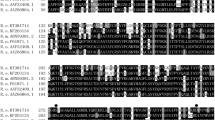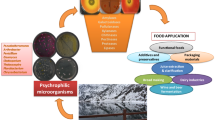Abstract
Objectives
Cold-active lipases which show high specific activity at low temperatures are attractive in industrial applications in terms of product stability and energy saving. We aimed to identify novel cold-active lipase suitable for oleates synthesis and bread making.
Results
A novel lipase gene (RmLipA) from Rhizopus microsporus was cloned and heterologously expressed in Pichia pastoris. The encoding sequence displayed 75% identity to the lipase from R. niveus. The highest extracellular lipase activity of 7931 U/mL was achieved in a 5-L fermentation. The recombinant enzyme (RmLipA) was optimally active at pH 8.0 and 20–25 °C, respectively, and stable over a wide pH range of 2.0–11.0. The enzyme was a cold-active lipase, exhibiting > 80% of its maximal activity at 0 °C. RmLipA was a sn-1,3 regioselective lipase, and preferred to hydrolyze pNP esters and triglycerides with relatively long chain fatty acids. RmLipA synthesized various oleates using oleic acid and different alcohols as substrates (> 95%). Moreover, it significantly improved the quality of bread by increasing its specific volume (21.7%) and decreasing its crumb firmness (28.6%).
Conclusions
A novel cold-active lipase gene from R. microsporus was identified, and its application potentials were evaluated. RmLipA should be a potential candidate in oleates synthesis and bread making industries.





Similar content being viewed by others
References
Andualema B, Gessesse A (2012) Microbial lipases and their industrial applications: review. Biotechnology 11(3):100–118
Borrelli GM, Trono D (2015) Recombinant lipases and phospholipases and their use as biocatalysts for industrial applications. Int J Mol Sci 16(9):20774–20840
Cai YJ, Wang L, Liao XR et al (2009) Purification and partial characterization of two new cold-adapted lipases from mesophilic Geotrichum sp. SYBC WU-3 Process Biochem 4(7):786–790
Casas-Godoy L, Gasteazoro F, Duquesne S et al (2018) Lipases: an overview. In: Lipases and phospholipases: methods and protocols, 2nd edn. 1835:3–38
Cavallaro V, Tonetto G, Ferreira ML (2019) Optimization of the enzymatic synthesis of pentyl oleate with lipase immobilized onto novel structured support. Ferment Basel 5(2):48
Cea M, Gonzalez ME, Abarzua M et al (2019) Enzymatic esterification of oleic acid by Candida rugose lipase immobilized onto biochar. J Environ Manag 242:171–177
Chen ML, Gao XZ, Yang W et al (2020) Discovery and characterization of a stable lipase with preference toward long-chain fatty acids. Biotechnol Lett 42:171–180
Duan XJ, Liu Y, You X et al (2013) High-level expression and characterization of a novel cutinase from Malbranchea cinnamomea suitable for butyl butyrate production. Biotechnol Biofuels 10:223
Duan XJ, Zheng MM, Liu Y et al (2016) High-level expression and biochemical characterization of a novel cold-active lipase from Rhizomucor endophyticus. Biotechnol Lett 38(12):2127–2135
Duan XJ, Xiang M, Wang L et al (2019) Biochemical characterization of a novel lipase from Malbranchea cinnamomea suitable for production of lipolyzed milkfat flavor and biodegradation of phthalate esters. Food Chem 297:UNSP124925
Florczak T, Daroch M, Wilkinson MC et al (2013) Purification, characterisation and expression in Saccharomyces cerevisiae of LipG7 an enantioselective, cold-adapted lipase from the Antarctic filamentous fungus Geomyces sp. P7 with unusual thermostability characteristics. Enzyme Microbial Technol 53(1):18–24
Gupta KK, Jagtap S, Priya R et al (2018) Purification, characterization of alkaline cold active lipase from Acinetobacter radioresistens PR8 and development of a new zymography method for lipase detection. Protein Peptide Lett 25(10):897–907
Hasan F, Shah AA, Hameed A (2009) Methods for detection and characterization of lipases: a comprehensive review. Biotechnol Adv 27(6):782–798
Jain R, Pandey N, Pandey A (2019) Aggregation properties of cold-active lipase produced by a psychrotolerant strain of Pseudomonas palleroniana (GBPI_508). Biocatal Biotransform 38(4):263–273
Javed S, Azeem F, Hussain S et al (2018) Bacterial lipases: a review on purification and characterization. Prog Biophys Biol 132:23–34
Ji XL, Li S, Wang BQ et al (2015) Expression, purification and characterization of a functional, recombinant, cold-active lipase (LipA) from psychrotrophic Yersinia enterocolitica. Protein Expres Purif 115:125–131
Jiang ZQ, Le Bail A, Wu AM (2008) Effect of the thermostable xylanase B (XynB) from Thermotoga maritima on the quality of frozen partially baked bread. J Cereal Sci 47(2):172–179
Jiao LC, Zhou QH, Su ZX et al (2018) High-level extracellular production of Rhizopus oryzae lipase in Pichia pastoris via a strategy combining optimization of gene-copy number with co-expression of ERAD-related proteins. Protein Expres Purif 147:1–12
Khan NR, Jadhav SV, Rathod VK (2015) Lipase catalyzed synthesis of cetyl oleate using ultrasound: optimisation and kinetic studies. Ultrason Sonochem 27:522–529
Kim BY, Yoo W, Le LTHL et al (2019) Characterization and mutation anaylsis of a cold-active bacterial hormone-sensitive lipase from Salinisphaera sp. P7-4. Arch Biochem Biophys 663:132–142
Lodhi MA, Ye GN, Weeden NF et al (1994) A simple and efficient method for DNA extraction from grapevine cultivars and Vitis species. Plant Mol Biol Rep 12(1):6–13
Lowry OH, Rosebrough NJ, Farr AL et al (1951) Protein measurement with the folin phenol reagent. J Biol Chem 193(1):265–275
Maharana AK, Singh SM (2018) A cold and organic solvent tolerant lipase produced by Antarctic strain Rhodotorula sp. Y-23. J Basic Microbiol 58(4):331–342
Malekabadi S, Badoei-Dalfard A, Karami Z (2018) Biochemical characterization of a novel cold-active, halophilic and organic solvent-tolerant lipase from B. licheniformis KM12 with potential application for biodiesel production. Int J Biol Macromol 109:389–398
Marin-Suarez M, Mendez-Mateos D, Guadix A et al (2019) Reuse of immobilized lipases in the transesterification of waste fish oil for the production of biodiesel. Renew Energ 140:1–8
Martinez-Ruiz A, Tovar-Castro L, Garcia HS et al (2018) Continuous ethyl oleate synthesis by lipases produced by solid-state fermentation by Rhizopus microspores. Bioresour Technol 265:52–58
Mayilvahanan A, Ramchary A, Niraikulam A et al (2019) A green process for starch oleate synthesis by Cryptococcus sp. MTCC 5455 lipase and its potential as an emulsifying agent. Starch-Starke 71(2):1700325
Melis S, Morales WRM, Delcour JA (2019) Lipases in wheat flour bread making: importance of an appropriate balance between wheat endogenous lipids and their enzymatically released hydrolysis products. Food Chem 298, UNSP 125002
Novototskaya-Vlasova K, Petrovskaya L, Kryukova E et al (2013) Expression and chaperone-assisted refolding of a new cold-active lipase from Psychxrobacter cryohalolentis K5T. Protein Expres Purif 91(1):96–103
Salwoom L, Abd-Rahman RNZR, Salleh A et al (2019) New Recombinant cold-adapted and organic solvent tolerant lipase from psychrophilic Pseudomonas sp. LSK25, isolated from signy island Antarctica. Int J Mol Sci 20(6):1264
Serventi L, Skibsted LH, Kidmose U (2019) Sensory and textural characterization of composite wheat-cassava bread as a function of lipase dose and storage time. Eur Food Res Technol 246(1):23–32
Stergiou PY, Foukis A, Filippou M et al (2013) Advances in lipase-catalyzed esterification reactions. Biotechnol Adv 31(8):1846–1859
Sugihara A, Shimada Y, Tominaga Y (1991) A novel Geotrichum candidum lipase with some preference for the 2-position on a triglyceride molecule. Appl Microbiol Biotechnol 35(6):738–740
Yan QJ, Duan XJ, Liu Y et al (2016) Expression and characterization of a novel 1,3-regioselective cold-adapted lipase from Rhizomucor endophyticus suitable for biodiesel synthesis. Biotechnol Biofuels 9:86
Yi ZW, Chan ZH, Yang F et al (2015) Optimization of cold-active lipase production by CALIP1 from deep-sea sediment-derived metagenomic library. Res J Biotechnol 10(4):91–97
Yu XW, Lu X, Zhao LS et al (2013) Impact of NH4+ nitrogen source on the production of Rhizopus oryzae lipase in Pichia pastoris. Food Chem 48(10):1462–1468
Zhang Y, Ji FL, Wang JY et al (2018) Purification and characterization of a novel organic solvent-tolerant and cold-adapted lipase from Psychrobacter sp. ZY124. Extremophiles 22(2):287–300
Acknowledgements
This study was financially supported by the National Natural Science Foundation of China (No. 31871744), the Open Project Program of Beijing Key Laboratory of Flavor Chemistry, Beijing Technology and Business University (BTBU), Beijing 100048, China (SPFWHX-2016-ZD) and National Key Research and Development Program of China (2018YFD0401102).
Author information
Authors and Affiliations
Corresponding author
Ethics declarations
Conflict of interest
The authors declare that they do not have any conflict of interest.
Additional information
Publisher’s Note
Springer Nature remains neutral with regard to jurisdictional claims in published maps and institutional affiliations.
Supplementary Information
Below is the link to the electronic supplementary material.
Rights and permissions
About this article
Cite this article
Xiang, M., Wang, L., Yan, Q. et al. Heterologous expression and biochemical characterization of a cold-active lipase from Rhizopus microsporus suitable for oleate synthesis and bread making. Biotechnol Lett 43, 1921–1932 (2021). https://doi.org/10.1007/s10529-021-03167-1
Received:
Accepted:
Published:
Issue Date:
DOI: https://doi.org/10.1007/s10529-021-03167-1




